An Essay on the Design of the Human Mind: Altruism vs. Selflessness
VerifiedAdded on 2023/01/13
|8
|2136
|34
Essay
AI Summary
This essay addresses the question of whether the human mind is designed to be truly selfless. It examines various theoretical perspectives on altruism, including kin selection theory, and presents evidence supporting these theories. The essay begins by acknowledging the traditional focus on competition and natural selection in evolutionary theory, while highlighting the importance of social reciprocity and charity for human survival. It then explores the debate on whether humans are inherently greedy or generous, and whether these tendencies are shaped by genes and environment. The essay provides examples of altruistic behaviors, such as donating blood and volunteering, while also acknowledging instances of selfish behavior. It discusses the kin selection theory, which explains altruism based on genetic relatedness, and identifies both supporting evidence and criticisms of the theory. The essay concludes that, while there is evidence of both cooperative and selfish behaviors, the human mind is indeed designed for being truly selfless and at the early stages of life, infants do exhibit the empathy towards other people in distress.

Running head: IS HUMAN MIND DESIGNED TO BE TRULY SELFLESS?
Is Human Mind Designed to be Truly Selfless?
Name of the Student:
Name of the University:
Author note:
Is Human Mind Designed to be Truly Selfless?
Name of the Student:
Name of the University:
Author note:
Paraphrase This Document
Need a fresh take? Get an instant paraphrase of this document with our AI Paraphraser

1IS HUMAN MIND DESIGNED TO BE TRULY SELFLESS?
The evolutionary theorists all around the world have traditionally focused on the
competition as well as on the ruthlessness of natural selection. However, often they have
failed to consider an important fact and that is- humans could not have survived this longer in
nature in absence of social reciprocity and charity of a group (Crockett & Lockwood, 2018).
Thinkers are still out on whether human beings are fundamentally greedy or generous and
whether these tendencies of theirs are shaped by their genes and environment. This paper
shall elaborate on addressing the topic of whether human mind is deigned to be truly selfless
or not. It shall take into consideration the different theoretical perspectives on altruism and at
the same time, shall highlight the evidence in support of the theories. It shall also shed light
kin selection theory and would identify whether there is any evidence that disconfirms this
theory.
There are several evidences that supports the claim that human mind is innately
cooperative. There are several studies that demonstrate that in the very initial years of life,
infants show empathy towards the ones they see distressed. However, in their later stages,
human minds routinely work together for reaching their goals and helping out in times when
other seek for help. Still, there are several instances of selfish behaviour among the human
beings that are abound in the society. According to Kruger (2003), the behaviour or the
nature of human beings that is designed for increasing the welfare of other persons without
wanting any direct reward in return is known as Altruism. Some of significant examples of
Altruism are donating blood, donating to a charity, taking actions for preventing crimes or
volunteering at a homeless shelter. There are several acts of helping that human beings
perform every day. Some of these actions represent true altruism and some, do not. The ones
who do not represent true altruism represent the kind of helping that is motivated more by the
self-concerns of human beings. Examples of such activities may include the tragedy of
The evolutionary theorists all around the world have traditionally focused on the
competition as well as on the ruthlessness of natural selection. However, often they have
failed to consider an important fact and that is- humans could not have survived this longer in
nature in absence of social reciprocity and charity of a group (Crockett & Lockwood, 2018).
Thinkers are still out on whether human beings are fundamentally greedy or generous and
whether these tendencies of theirs are shaped by their genes and environment. This paper
shall elaborate on addressing the topic of whether human mind is deigned to be truly selfless
or not. It shall take into consideration the different theoretical perspectives on altruism and at
the same time, shall highlight the evidence in support of the theories. It shall also shed light
kin selection theory and would identify whether there is any evidence that disconfirms this
theory.
There are several evidences that supports the claim that human mind is innately
cooperative. There are several studies that demonstrate that in the very initial years of life,
infants show empathy towards the ones they see distressed. However, in their later stages,
human minds routinely work together for reaching their goals and helping out in times when
other seek for help. Still, there are several instances of selfish behaviour among the human
beings that are abound in the society. According to Kruger (2003), the behaviour or the
nature of human beings that is designed for increasing the welfare of other persons without
wanting any direct reward in return is known as Altruism. Some of significant examples of
Altruism are donating blood, donating to a charity, taking actions for preventing crimes or
volunteering at a homeless shelter. There are several acts of helping that human beings
perform every day. Some of these actions represent true altruism and some, do not. The ones
who do not represent true altruism represent the kind of helping that is motivated more by the
self-concerns of human beings. Examples of such activities may include the tragedy of
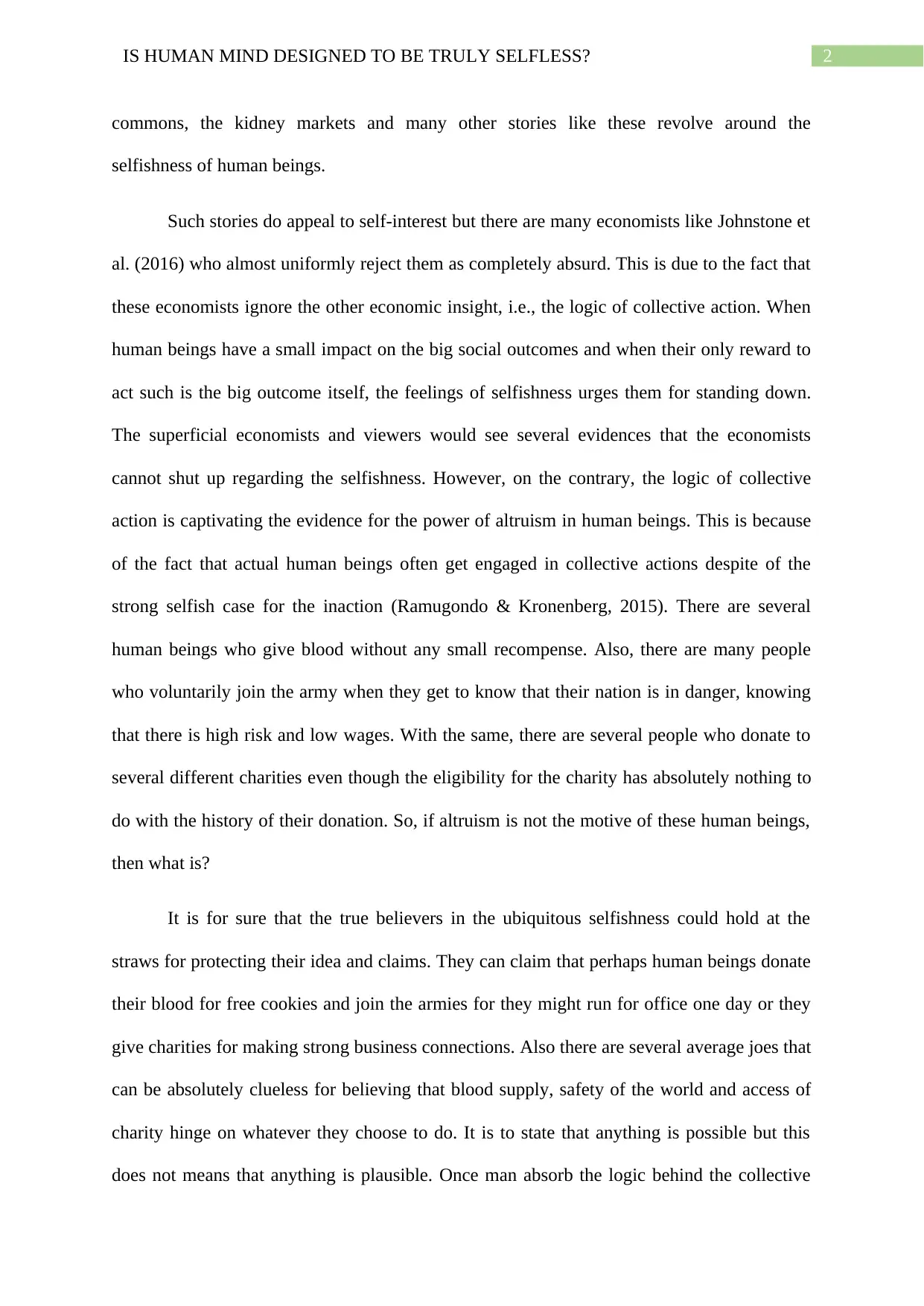
2IS HUMAN MIND DESIGNED TO BE TRULY SELFLESS?
commons, the kidney markets and many other stories like these revolve around the
selfishness of human beings.
Such stories do appeal to self-interest but there are many economists like Johnstone et
al. (2016) who almost uniformly reject them as completely absurd. This is due to the fact that
these economists ignore the other economic insight, i.e., the logic of collective action. When
human beings have a small impact on the big social outcomes and when their only reward to
act such is the big outcome itself, the feelings of selfishness urges them for standing down.
The superficial economists and viewers would see several evidences that the economists
cannot shut up regarding the selfishness. However, on the contrary, the logic of collective
action is captivating the evidence for the power of altruism in human beings. This is because
of the fact that actual human beings often get engaged in collective actions despite of the
strong selfish case for the inaction (Ramugondo & Kronenberg, 2015). There are several
human beings who give blood without any small recompense. Also, there are many people
who voluntarily join the army when they get to know that their nation is in danger, knowing
that there is high risk and low wages. With the same, there are several people who donate to
several different charities even though the eligibility for the charity has absolutely nothing to
do with the history of their donation. So, if altruism is not the motive of these human beings,
then what is?
It is for sure that the true believers in the ubiquitous selfishness could hold at the
straws for protecting their idea and claims. They can claim that perhaps human beings donate
their blood for free cookies and join the armies for they might run for office one day or they
give charities for making strong business connections. Also there are several average joes that
can be absolutely clueless for believing that blood supply, safety of the world and access of
charity hinge on whatever they choose to do. It is to state that anything is possible but this
does not means that anything is plausible. Once man absorb the logic behind the collective
commons, the kidney markets and many other stories like these revolve around the
selfishness of human beings.
Such stories do appeal to self-interest but there are many economists like Johnstone et
al. (2016) who almost uniformly reject them as completely absurd. This is due to the fact that
these economists ignore the other economic insight, i.e., the logic of collective action. When
human beings have a small impact on the big social outcomes and when their only reward to
act such is the big outcome itself, the feelings of selfishness urges them for standing down.
The superficial economists and viewers would see several evidences that the economists
cannot shut up regarding the selfishness. However, on the contrary, the logic of collective
action is captivating the evidence for the power of altruism in human beings. This is because
of the fact that actual human beings often get engaged in collective actions despite of the
strong selfish case for the inaction (Ramugondo & Kronenberg, 2015). There are several
human beings who give blood without any small recompense. Also, there are many people
who voluntarily join the army when they get to know that their nation is in danger, knowing
that there is high risk and low wages. With the same, there are several people who donate to
several different charities even though the eligibility for the charity has absolutely nothing to
do with the history of their donation. So, if altruism is not the motive of these human beings,
then what is?
It is for sure that the true believers in the ubiquitous selfishness could hold at the
straws for protecting their idea and claims. They can claim that perhaps human beings donate
their blood for free cookies and join the armies for they might run for office one day or they
give charities for making strong business connections. Also there are several average joes that
can be absolutely clueless for believing that blood supply, safety of the world and access of
charity hinge on whatever they choose to do. It is to state that anything is possible but this
does not means that anything is plausible. Once man absorb the logic behind the collective
⊘ This is a preview!⊘
Do you want full access?
Subscribe today to unlock all pages.

Trusted by 1+ million students worldwide
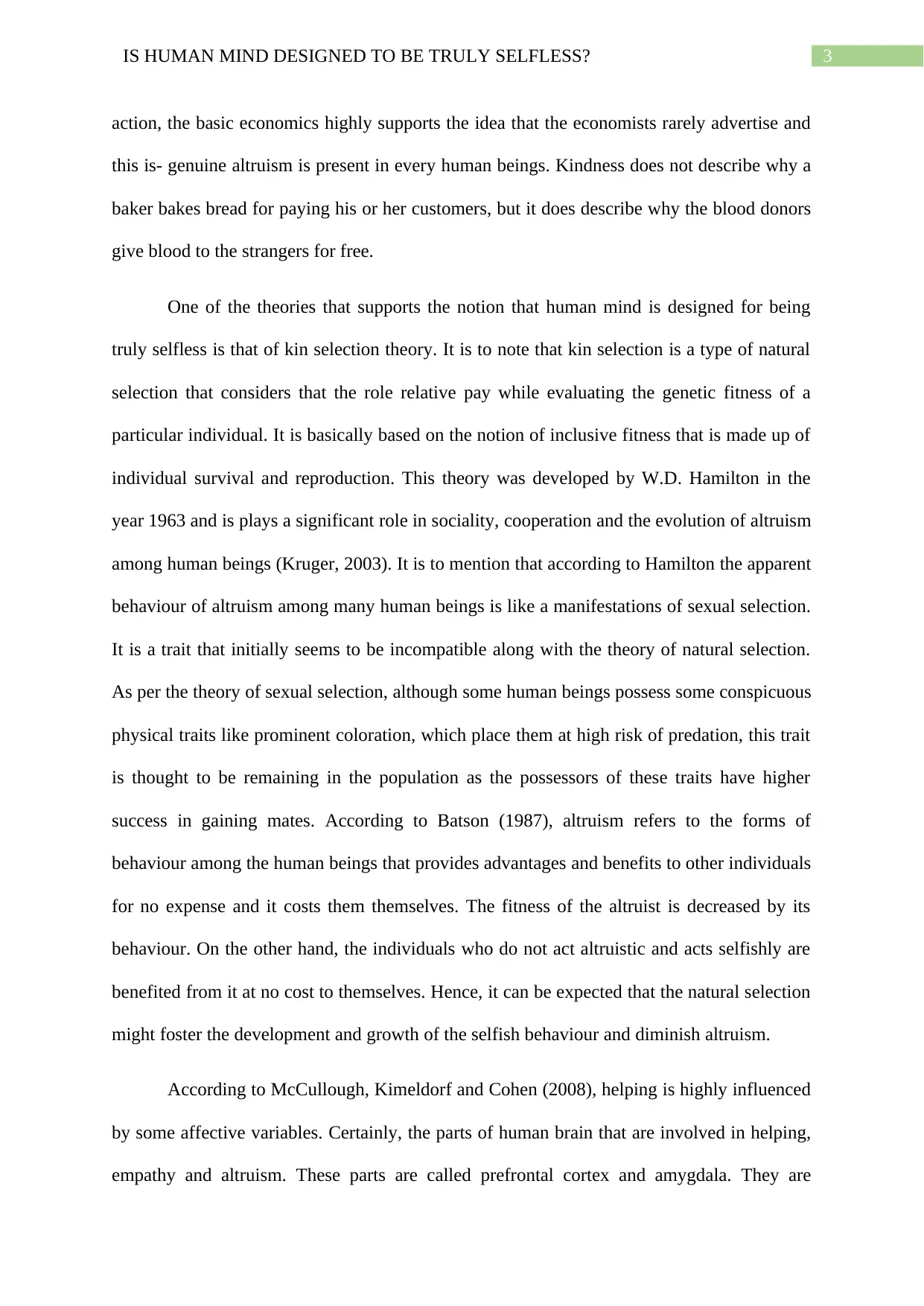
3IS HUMAN MIND DESIGNED TO BE TRULY SELFLESS?
action, the basic economics highly supports the idea that the economists rarely advertise and
this is- genuine altruism is present in every human beings. Kindness does not describe why a
baker bakes bread for paying his or her customers, but it does describe why the blood donors
give blood to the strangers for free.
One of the theories that supports the notion that human mind is designed for being
truly selfless is that of kin selection theory. It is to note that kin selection is a type of natural
selection that considers that the role relative pay while evaluating the genetic fitness of a
particular individual. It is basically based on the notion of inclusive fitness that is made up of
individual survival and reproduction. This theory was developed by W.D. Hamilton in the
year 1963 and is plays a significant role in sociality, cooperation and the evolution of altruism
among human beings (Kruger, 2003). It is to mention that according to Hamilton the apparent
behaviour of altruism among many human beings is like a manifestations of sexual selection.
It is a trait that initially seems to be incompatible along with the theory of natural selection.
As per the theory of sexual selection, although some human beings possess some conspicuous
physical traits like prominent coloration, which place them at high risk of predation, this trait
is thought to be remaining in the population as the possessors of these traits have higher
success in gaining mates. According to Batson (1987), altruism refers to the forms of
behaviour among the human beings that provides advantages and benefits to other individuals
for no expense and it costs them themselves. The fitness of the altruist is decreased by its
behaviour. On the other hand, the individuals who do not act altruistic and acts selfishly are
benefited from it at no cost to themselves. Hence, it can be expected that the natural selection
might foster the development and growth of the selfish behaviour and diminish altruism.
According to McCullough, Kimeldorf and Cohen (2008), helping is highly influenced
by some affective variables. Certainly, the parts of human brain that are involved in helping,
empathy and altruism. These parts are called prefrontal cortex and amygdala. They are
action, the basic economics highly supports the idea that the economists rarely advertise and
this is- genuine altruism is present in every human beings. Kindness does not describe why a
baker bakes bread for paying his or her customers, but it does describe why the blood donors
give blood to the strangers for free.
One of the theories that supports the notion that human mind is designed for being
truly selfless is that of kin selection theory. It is to note that kin selection is a type of natural
selection that considers that the role relative pay while evaluating the genetic fitness of a
particular individual. It is basically based on the notion of inclusive fitness that is made up of
individual survival and reproduction. This theory was developed by W.D. Hamilton in the
year 1963 and is plays a significant role in sociality, cooperation and the evolution of altruism
among human beings (Kruger, 2003). It is to mention that according to Hamilton the apparent
behaviour of altruism among many human beings is like a manifestations of sexual selection.
It is a trait that initially seems to be incompatible along with the theory of natural selection.
As per the theory of sexual selection, although some human beings possess some conspicuous
physical traits like prominent coloration, which place them at high risk of predation, this trait
is thought to be remaining in the population as the possessors of these traits have higher
success in gaining mates. According to Batson (1987), altruism refers to the forms of
behaviour among the human beings that provides advantages and benefits to other individuals
for no expense and it costs them themselves. The fitness of the altruist is decreased by its
behaviour. On the other hand, the individuals who do not act altruistic and acts selfishly are
benefited from it at no cost to themselves. Hence, it can be expected that the natural selection
might foster the development and growth of the selfish behaviour and diminish altruism.
According to McCullough, Kimeldorf and Cohen (2008), helping is highly influenced
by some affective variables. Certainly, the parts of human brain that are involved in helping,
empathy and altruism. These parts are called prefrontal cortex and amygdala. They are
Paraphrase This Document
Need a fresh take? Get an instant paraphrase of this document with our AI Paraphraser
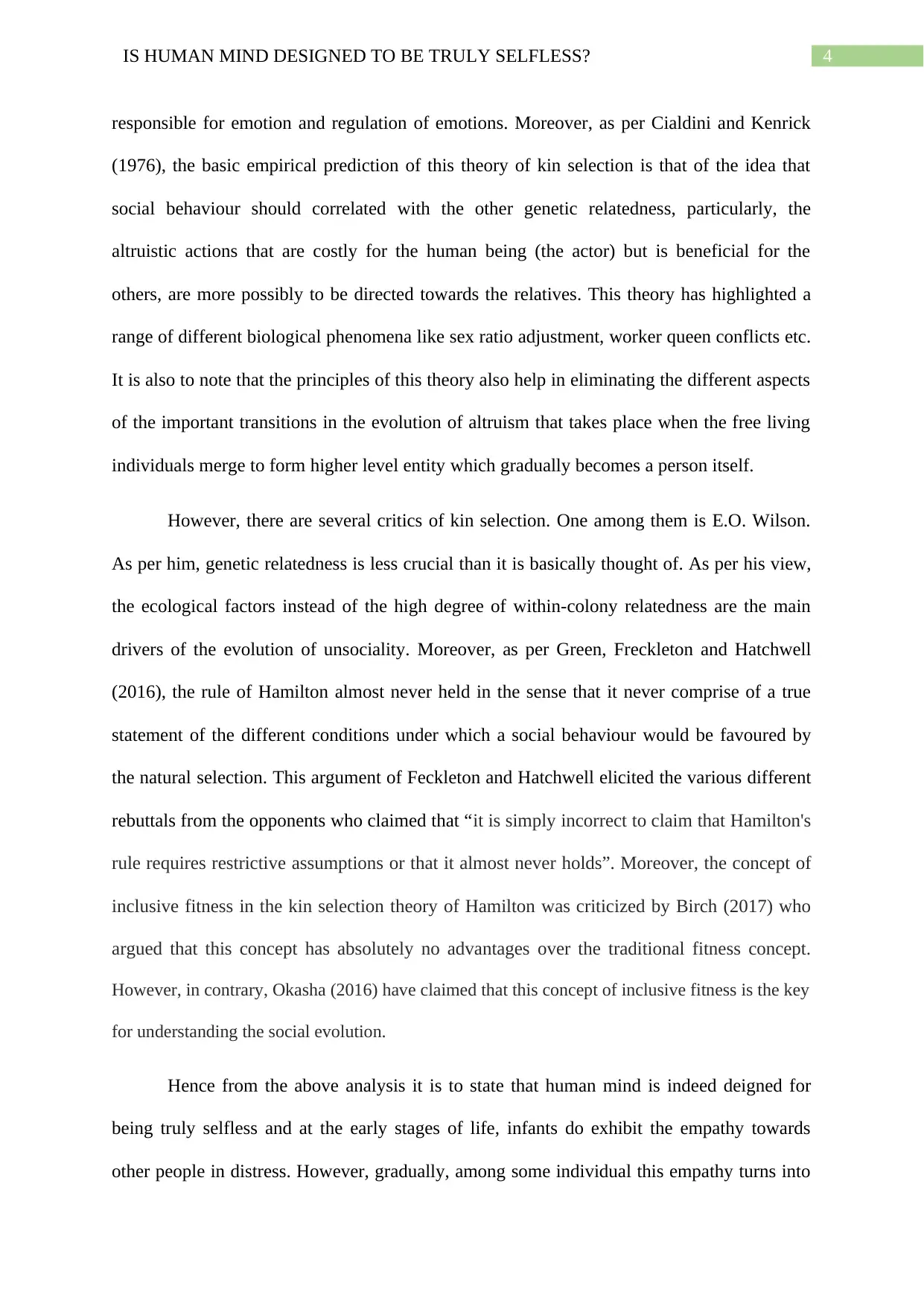
4IS HUMAN MIND DESIGNED TO BE TRULY SELFLESS?
responsible for emotion and regulation of emotions. Moreover, as per Cialdini and Kenrick
(1976), the basic empirical prediction of this theory of kin selection is that of the idea that
social behaviour should correlated with the other genetic relatedness, particularly, the
altruistic actions that are costly for the human being (the actor) but is beneficial for the
others, are more possibly to be directed towards the relatives. This theory has highlighted a
range of different biological phenomena like sex ratio adjustment, worker queen conflicts etc.
It is also to note that the principles of this theory also help in eliminating the different aspects
of the important transitions in the evolution of altruism that takes place when the free living
individuals merge to form higher level entity which gradually becomes a person itself.
However, there are several critics of kin selection. One among them is E.O. Wilson.
As per him, genetic relatedness is less crucial than it is basically thought of. As per his view,
the ecological factors instead of the high degree of within-colony relatedness are the main
drivers of the evolution of unsociality. Moreover, as per Green, Freckleton and Hatchwell
(2016), the rule of Hamilton almost never held in the sense that it never comprise of a true
statement of the different conditions under which a social behaviour would be favoured by
the natural selection. This argument of Feckleton and Hatchwell elicited the various different
rebuttals from the opponents who claimed that “it is simply incorrect to claim that Hamilton's
rule requires restrictive assumptions or that it almost never holds”. Moreover, the concept of
inclusive fitness in the kin selection theory of Hamilton was criticized by Birch (2017) who
argued that this concept has absolutely no advantages over the traditional fitness concept.
However, in contrary, Okasha (2016) have claimed that this concept of inclusive fitness is the key
for understanding the social evolution.
Hence from the above analysis it is to state that human mind is indeed deigned for
being truly selfless and at the early stages of life, infants do exhibit the empathy towards
other people in distress. However, gradually, among some individual this empathy turns into
responsible for emotion and regulation of emotions. Moreover, as per Cialdini and Kenrick
(1976), the basic empirical prediction of this theory of kin selection is that of the idea that
social behaviour should correlated with the other genetic relatedness, particularly, the
altruistic actions that are costly for the human being (the actor) but is beneficial for the
others, are more possibly to be directed towards the relatives. This theory has highlighted a
range of different biological phenomena like sex ratio adjustment, worker queen conflicts etc.
It is also to note that the principles of this theory also help in eliminating the different aspects
of the important transitions in the evolution of altruism that takes place when the free living
individuals merge to form higher level entity which gradually becomes a person itself.
However, there are several critics of kin selection. One among them is E.O. Wilson.
As per him, genetic relatedness is less crucial than it is basically thought of. As per his view,
the ecological factors instead of the high degree of within-colony relatedness are the main
drivers of the evolution of unsociality. Moreover, as per Green, Freckleton and Hatchwell
(2016), the rule of Hamilton almost never held in the sense that it never comprise of a true
statement of the different conditions under which a social behaviour would be favoured by
the natural selection. This argument of Feckleton and Hatchwell elicited the various different
rebuttals from the opponents who claimed that “it is simply incorrect to claim that Hamilton's
rule requires restrictive assumptions or that it almost never holds”. Moreover, the concept of
inclusive fitness in the kin selection theory of Hamilton was criticized by Birch (2017) who
argued that this concept has absolutely no advantages over the traditional fitness concept.
However, in contrary, Okasha (2016) have claimed that this concept of inclusive fitness is the key
for understanding the social evolution.
Hence from the above analysis it is to state that human mind is indeed deigned for
being truly selfless and at the early stages of life, infants do exhibit the empathy towards
other people in distress. However, gradually, among some individual this empathy turns into
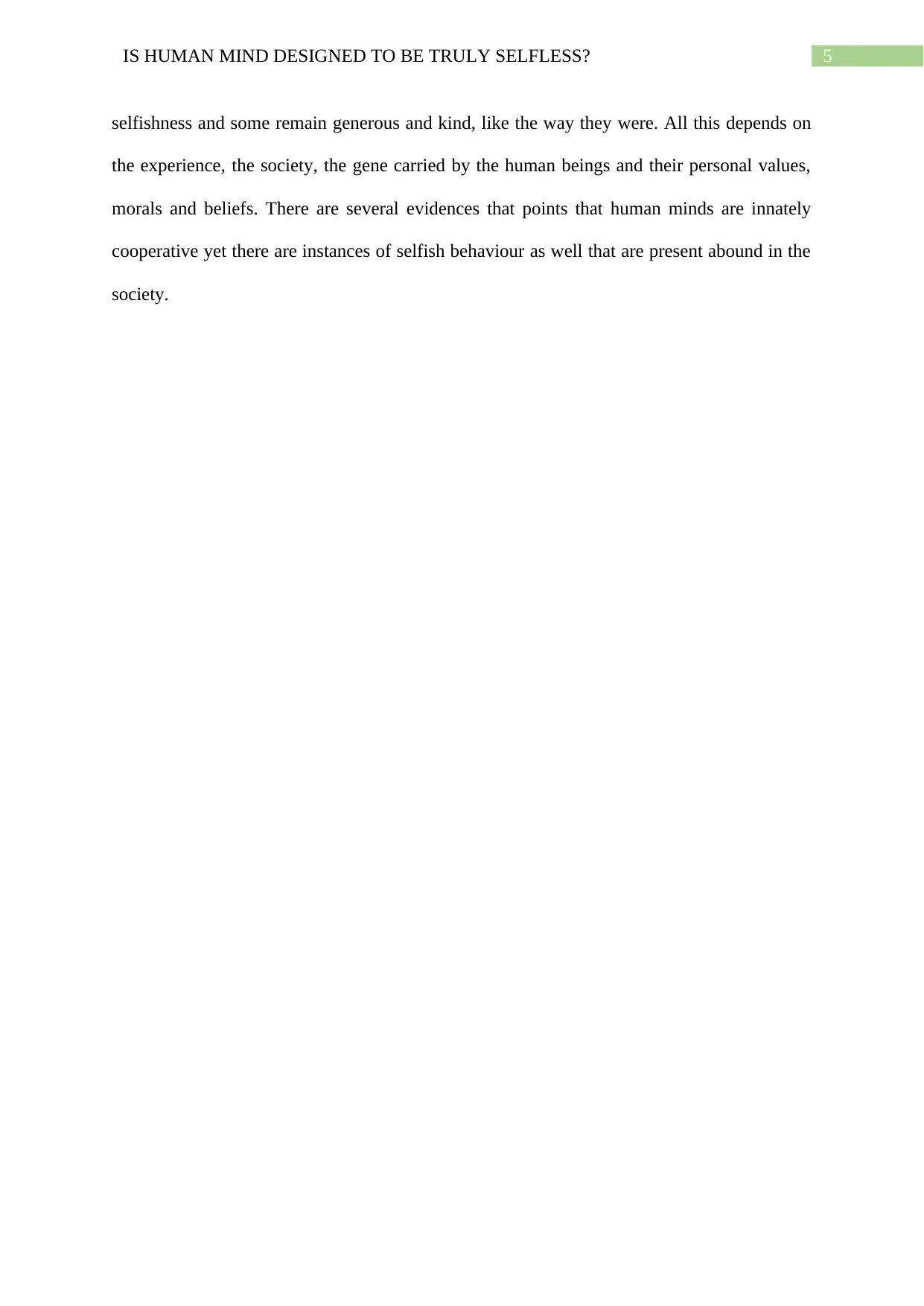
5IS HUMAN MIND DESIGNED TO BE TRULY SELFLESS?
selfishness and some remain generous and kind, like the way they were. All this depends on
the experience, the society, the gene carried by the human beings and their personal values,
morals and beliefs. There are several evidences that points that human minds are innately
cooperative yet there are instances of selfish behaviour as well that are present abound in the
society.
selfishness and some remain generous and kind, like the way they were. All this depends on
the experience, the society, the gene carried by the human beings and their personal values,
morals and beliefs. There are several evidences that points that human minds are innately
cooperative yet there are instances of selfish behaviour as well that are present abound in the
society.
⊘ This is a preview!⊘
Do you want full access?
Subscribe today to unlock all pages.

Trusted by 1+ million students worldwide
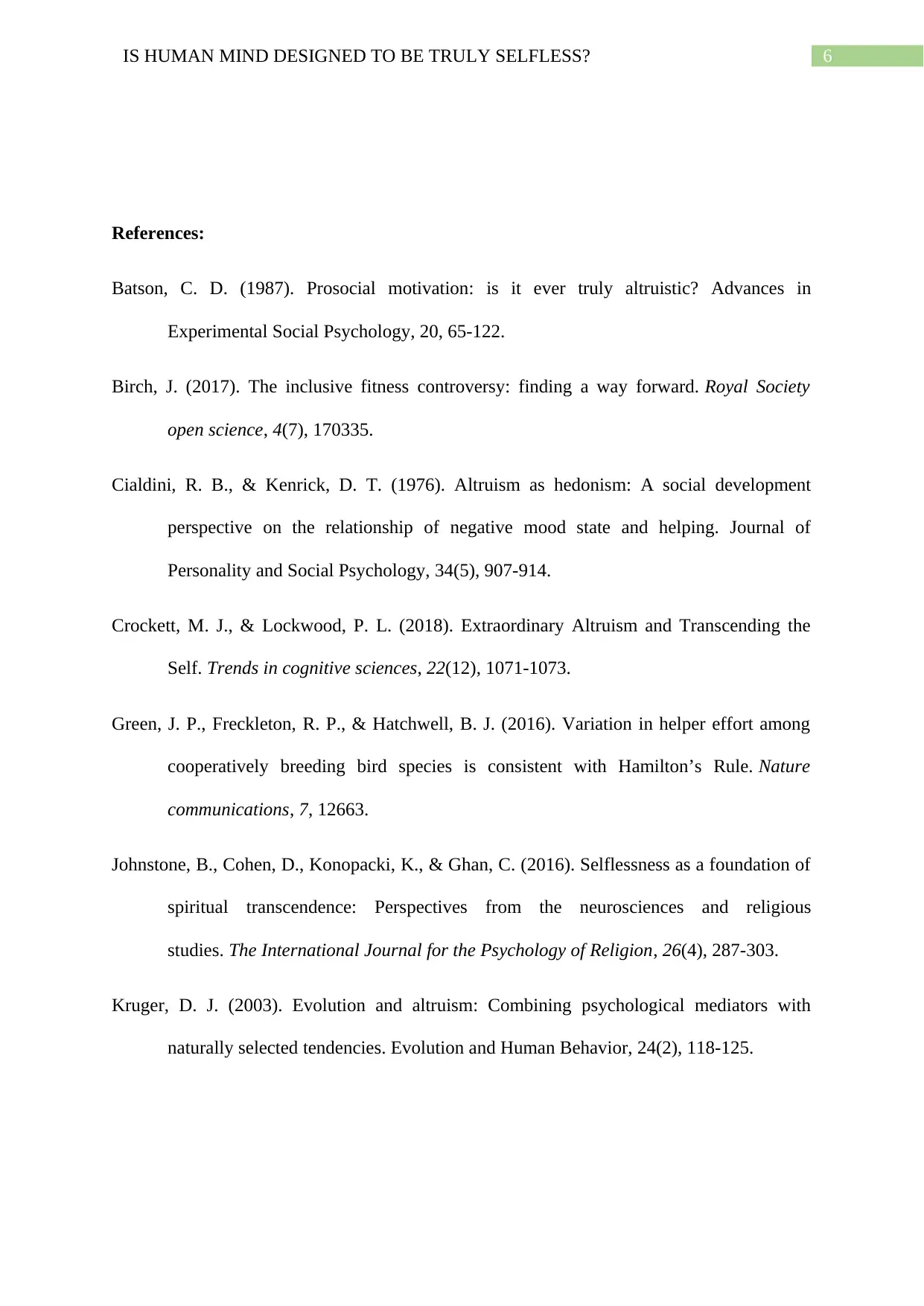
6IS HUMAN MIND DESIGNED TO BE TRULY SELFLESS?
References:
Batson, C. D. (1987). Prosocial motivation: is it ever truly altruistic? Advances in
Experimental Social Psychology, 20, 65-122.
Birch, J. (2017). The inclusive fitness controversy: finding a way forward. Royal Society
open science, 4(7), 170335.
Cialdini, R. B., & Kenrick, D. T. (1976). Altruism as hedonism: A social development
perspective on the relationship of negative mood state and helping. Journal of
Personality and Social Psychology, 34(5), 907-914.
Crockett, M. J., & Lockwood, P. L. (2018). Extraordinary Altruism and Transcending the
Self. Trends in cognitive sciences, 22(12), 1071-1073.
Green, J. P., Freckleton, R. P., & Hatchwell, B. J. (2016). Variation in helper effort among
cooperatively breeding bird species is consistent with Hamilton’s Rule. Nature
communications, 7, 12663.
Johnstone, B., Cohen, D., Konopacki, K., & Ghan, C. (2016). Selflessness as a foundation of
spiritual transcendence: Perspectives from the neurosciences and religious
studies. The International Journal for the Psychology of Religion, 26(4), 287-303.
Kruger, D. J. (2003). Evolution and altruism: Combining psychological mediators with
naturally selected tendencies. Evolution and Human Behavior, 24(2), 118-125.
References:
Batson, C. D. (1987). Prosocial motivation: is it ever truly altruistic? Advances in
Experimental Social Psychology, 20, 65-122.
Birch, J. (2017). The inclusive fitness controversy: finding a way forward. Royal Society
open science, 4(7), 170335.
Cialdini, R. B., & Kenrick, D. T. (1976). Altruism as hedonism: A social development
perspective on the relationship of negative mood state and helping. Journal of
Personality and Social Psychology, 34(5), 907-914.
Crockett, M. J., & Lockwood, P. L. (2018). Extraordinary Altruism and Transcending the
Self. Trends in cognitive sciences, 22(12), 1071-1073.
Green, J. P., Freckleton, R. P., & Hatchwell, B. J. (2016). Variation in helper effort among
cooperatively breeding bird species is consistent with Hamilton’s Rule. Nature
communications, 7, 12663.
Johnstone, B., Cohen, D., Konopacki, K., & Ghan, C. (2016). Selflessness as a foundation of
spiritual transcendence: Perspectives from the neurosciences and religious
studies. The International Journal for the Psychology of Religion, 26(4), 287-303.
Kruger, D. J. (2003). Evolution and altruism: Combining psychological mediators with
naturally selected tendencies. Evolution and Human Behavior, 24(2), 118-125.
Paraphrase This Document
Need a fresh take? Get an instant paraphrase of this document with our AI Paraphraser
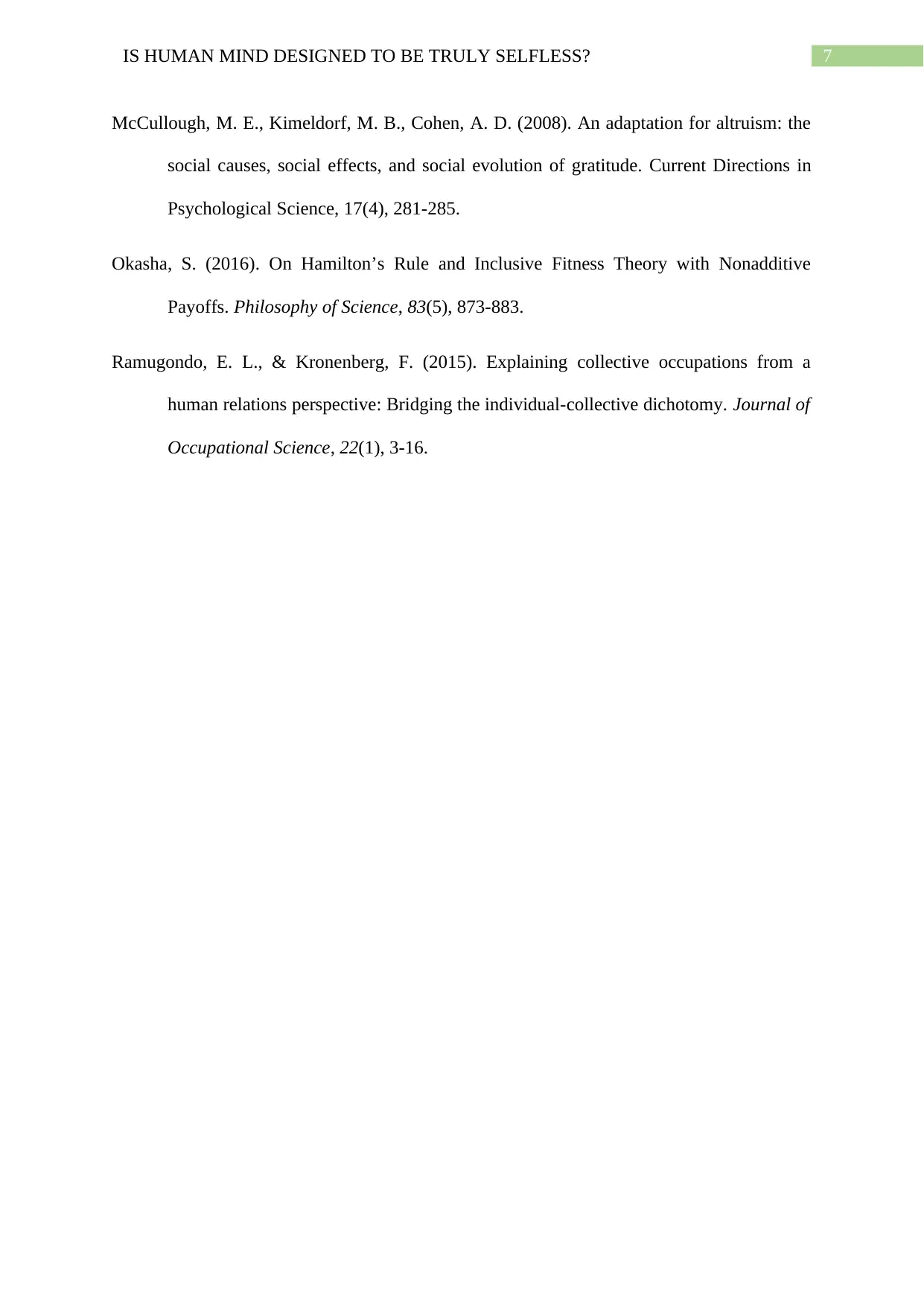
7IS HUMAN MIND DESIGNED TO BE TRULY SELFLESS?
McCullough, M. E., Kimeldorf, M. B., Cohen, A. D. (2008). An adaptation for altruism: the
social causes, social effects, and social evolution of gratitude. Current Directions in
Psychological Science, 17(4), 281-285.
Okasha, S. (2016). On Hamilton’s Rule and Inclusive Fitness Theory with Nonadditive
Payoffs. Philosophy of Science, 83(5), 873-883.
Ramugondo, E. L., & Kronenberg, F. (2015). Explaining collective occupations from a
human relations perspective: Bridging the individual-collective dichotomy. Journal of
Occupational Science, 22(1), 3-16.
McCullough, M. E., Kimeldorf, M. B., Cohen, A. D. (2008). An adaptation for altruism: the
social causes, social effects, and social evolution of gratitude. Current Directions in
Psychological Science, 17(4), 281-285.
Okasha, S. (2016). On Hamilton’s Rule and Inclusive Fitness Theory with Nonadditive
Payoffs. Philosophy of Science, 83(5), 873-883.
Ramugondo, E. L., & Kronenberg, F. (2015). Explaining collective occupations from a
human relations perspective: Bridging the individual-collective dichotomy. Journal of
Occupational Science, 22(1), 3-16.
1 out of 8
Your All-in-One AI-Powered Toolkit for Academic Success.
+13062052269
info@desklib.com
Available 24*7 on WhatsApp / Email
![[object Object]](/_next/static/media/star-bottom.7253800d.svg)
Unlock your academic potential
Copyright © 2020–2026 A2Z Services. All Rights Reserved. Developed and managed by ZUCOL.